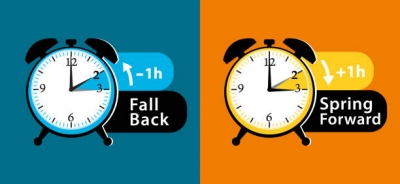
It has been a common practice in some parts of the world to reset the clock in March and November every year to follow Daylight Saving Time. The United States is among the first countries to moot the idea of Daylight Saving Time, by which all the clocks are moved forward by an hour during the summer months and brought back during the winter. The reason behind this is to take advantage of the long-lasting sunlight in summer and save energy. But on March 15, the U.S. passed a legislation to make daylight-saving time permanent starting in 2023. The bill would still need to be approved by the House and President Joe Biden to become law. However, many parts of North America and Europe continue to follow Daylight Saving Time (DST).
WHAT is the logic behind this practice?
Seasons are caused by the tilt of the Earth’s axis. When the tilted North Pole points towards the sun, the Northern Hemisphere has summer. It gets more of the sun’s rays. When it is summer in the Northern Hemisphere, it is winter in the Southern Hemisphere. Generally. the daylight lasts longer in summer and shorter in winter. The Daylight Saving Time was ideated to take advantage of this ‘extra’ daylight. Some countries reset their clocks an hour ahead, so that people will begin and complete their daily work routine an hour earlier. Longer daylight enables them to engage in leisure, shopping and physical activities. This will not only help businesses, but will also keep people happy and healthy. Further, the longer the brightness in the evening hours, the lesser the need for artificial lighting. This will help reduce energy consumption.
HOW is it done?
Let us take the example of the U.S. to understand this. DST begins on the second Sunday in March, when people advance their clocks by an hour at 2 a.m. local standard time (so at 2 a.m. on that day, the clocks will read 3 a.m.) The new time will remain in force till the first Sunday in November, when the clocks will be moved back by an hour at 2 a.m. local daylight time.
WHY are objections raised against DST?
Opponents argue that the actual energy saving through DST is debatable. Research proving energy conservation through DST has been limited. DST affects farmers the most. as labourers arrive and leave early in countries that follow DST. DST has been found to have mixed effects on people’s health. Though it encourages physical activities in the evening hours, it could alter sunlight exposure, reduce sleep hours and affect mental functioning. It is also found that road and rail accidents are high in the days immediately following the clock change according to studies conducted in North America. Some experts argue that with climate change affecting weather and seasons, following DST is irrelevant.
WHEN did it all start?
Benjamin Franklin, one of the founding fathers of the United States, is believed to have come up with the idea in 1784, when he published an essay “An Economical Project for Diminishing the Cost of Light,” in the Journal de Paris. However, it was William Willett, a British builder, who was instrumental in bringing in a law in favour of DST in England. He campaigned for the introduction of British Summer Time. Though the British House of Commons rejected his proposal in 1908, it passed the Bill in May 1916. The British Summer Time became a reality on May 21, 1916, days after Germany reset its clocks on May 1, 1916, to save coal (which was used to generate energy) during World War I. The first U.S. law on Daylight Saving Time went into effect on March 19, 1918, for the same reason. However, it was not until 1966 that the U.S. had a uniform national period of daylight-saving time with the passing of the Uniform Time Act.
WHICH are the regions that follow DST?
Most areas in North America and Europe, and some in the Middle East, observe DST, while most areas of Africa and Asia do not. In South America, Australia and New Zealand, some parts observe, while some do not.
Picture Credit : Google




